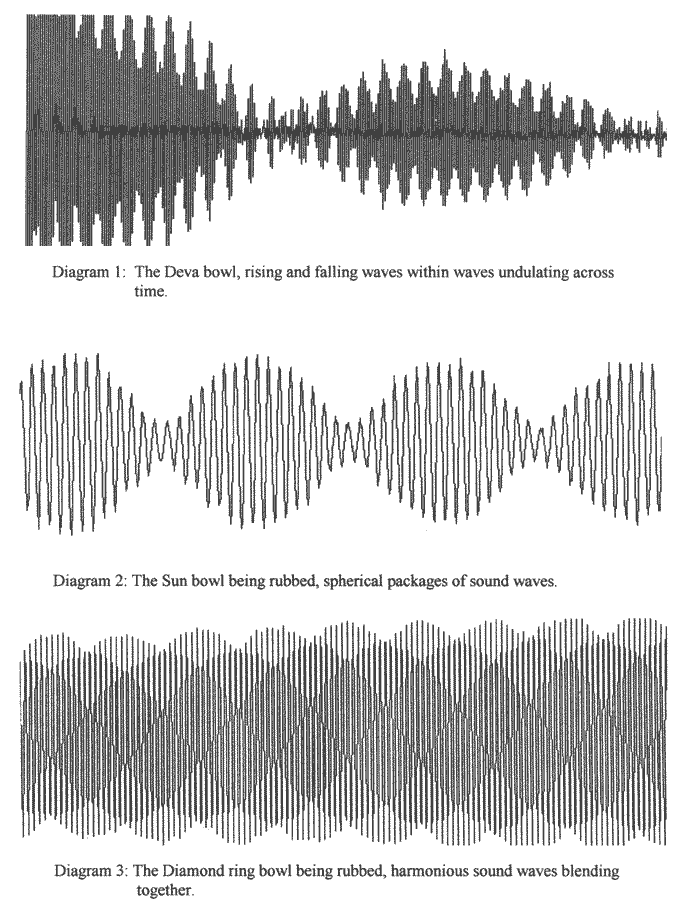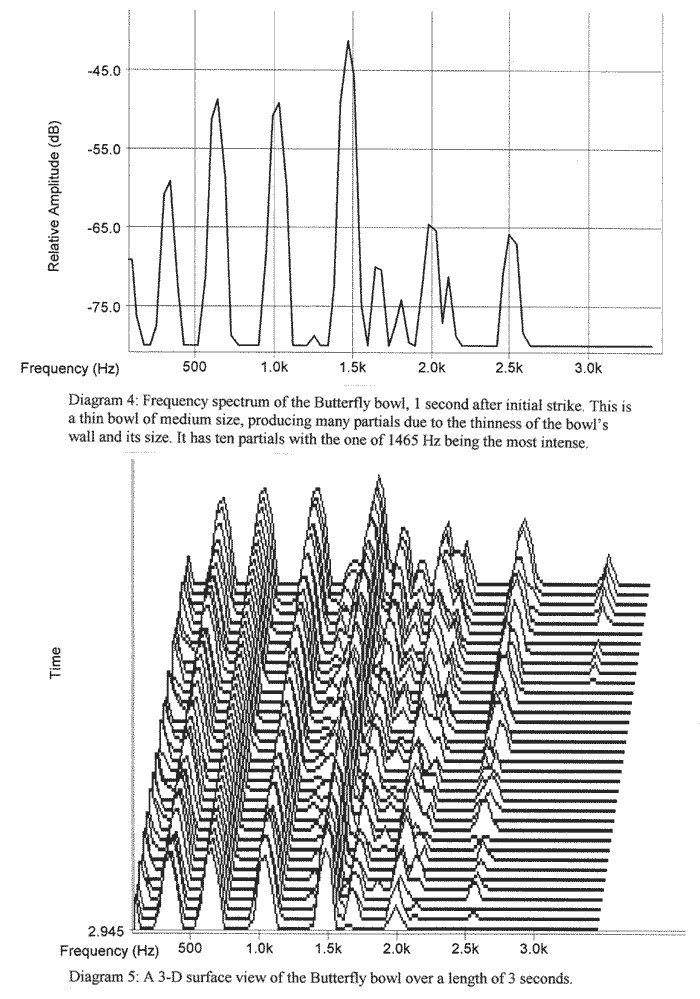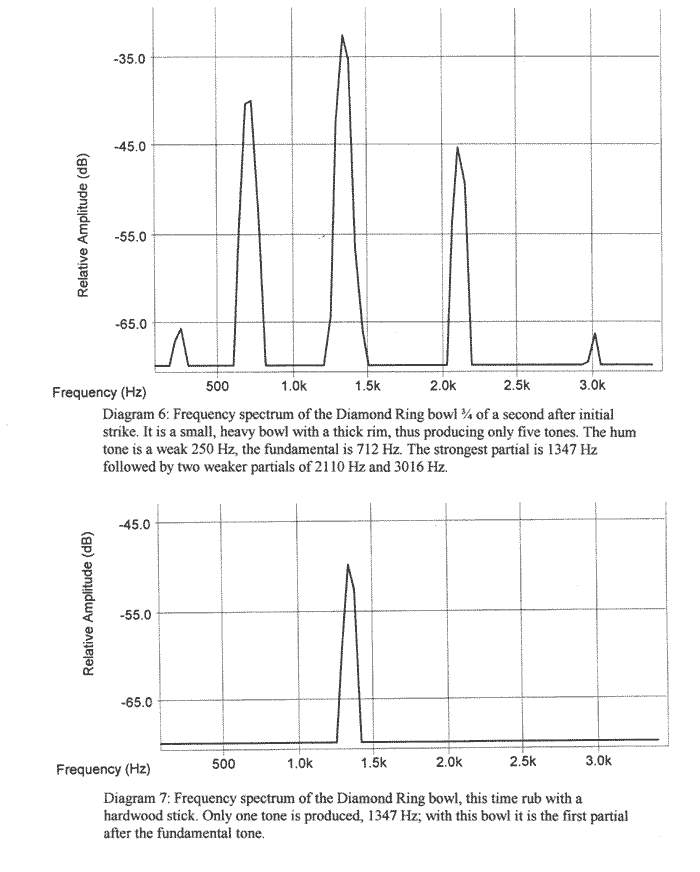|
6. Altered Brain Waves
Music is a miniature of the harmony of
the whole universe, for the harmony of the universe is life itself, and
humans, being a miniature of the universe, show harmonious and
inharmonious chords in their pulsations, in the beat of their hearts, in
their vibration, rhythm and tone.
Hazrat Inayat Khan
An invitation to an open house at the Stone Mountain Counseling
Center in New Paltz, NY, led to an interesting experiment. The owner of
the center asked me to bring some singing bowls. I lectured about the
bowls for a small group of people. All were very interested. One of the
participants, Barbara, was hooked up to a brain wave monitor while I
placed the bowls on and around her. Barbara had been suffering from
depression for some time. On the monitor this showed up as high
amplitude Theta and Delta waves. At times during the session, these
brain waves would drop dramatically. This surprised Stephen, who runs
the center. Her average brain wave shifted towards Alpha and Beta,
indicating an uplifting mood. After the session Barbara told us that she
was feeling calm, happy and radiating. She had also seen numerous
images.
Brain waves are categorized into four groups: Alpha, Beta,
Delta and Theta. Alpha waves (7 to 12 Hz) arise when the eyes are closed
and the mind is in a relaxed state. In the deeper states associated with
Alpha waves (5 to 7 Hertz) there is a loss of awareness of the
environment as one drifts in a profound state of relaxation. Beta waves
(13-30 Hertz) reflect a state of alertness, attention, arousal and
anxiety. High Beta waves cause high energy levels and even hypertension.
Theta waves (4-7 Hertz) are responsible for a state of drowsiness and
dreaming. It is a twilight state which we normally only experience as we
wake up or fall asleep. Delta waves (0-4Hertz) are related to the
deepest, most relaxed state of sleep.
How do brain waves fit in with
singing bowls? Alfred Tomatis, a French surgeon, did experiments on the
relation between the ear, the brain and the nervous system. He
discovered that sound actually charges the brain. The little known
reason for this is that the first function of the ear is to make sure
the cortex receives sufficient neural energy through the "charging"
effect of sounds. This is often overlooked because doctors are misguided
by the generally accepted idea attributing a primarily auditory function
to the ear. Actually hearing is a secondary function. It is a well-known
fact in zoology that the auditory apparatus acts as a charging or
energizing dynamo. It furnishes current to feed the brain. Tomatis goes
even further and explains that the chain of small bones in the ear does
not simply carry sound from the outer to the inner ear. This sequence
bones has the function of putting the entire cranium into resonance.
Sound picked up by the eardrum circulates by means of this chain of
small bones throughout the cranium which as a result is made to vibrate.
The sound is distributed and regulated by a constant pressure in the
labyrinth.
The listening function does not only affect the ear, it
mobilizes the entire nervous system. This activation of neurons
regulates muscle tensions and the position of the body. Tomatis explains
that higher frequency sounds generally resonate in the brain and affect
cognitive functions, such as thinking, spatial perception, and memory.
Middle frequency sounds tend to stimulate the heart, lungs, and the
emotions. Lower sounds affect physical movement.
This explains the
link between the sounds of the singing bowls and the effects they
produce. Brain waves are rhythmic changes in electrical energy, receding
and swelling again and again like waves of the ocean. The sounds of the
singing bowls are likewise rhythmic, and it is easy to hear waves of
low, medium and high frequency in each bowl. Sound waves that correspond
to the four kinds of brain waves can be heard when playing a bowl.
Singing bowls seem to have a well balanced amount of each of the four
kinds of waves; listening to the bowls is like listening to brain waves.
Knowing that sound has such a profound effect on the brain, the bones of
the skull, and the entire nervous system, it is no wonder that singing
bowls can have such a profound effect on people. It explains why
participants in a session are so relaxed and happy afterwards, and how
the sounds work to create positive changes on physical and psychological
levels.
The sounds produced by singing bowls are rhythmic and
soothing, they come and go, again and again. Even though they are
monotonous the beauty of the intricate sound patterns they produce makes
them fascinating. Before you know it, you are entranced. One day I had a
sudden realization, hypnotism and trance states work in the same way. In
hypnosis an individual is led into a trance state by means of
monotonous, repetitive verbal commands, a swinging a pendulum, eye
fixation, and muscle relaxation. We can also slip into a trance state
naturally. Hypnotic or trance states are not that exotic, they happen to
us every day. Daydreaming, crossing over into sleep at night, the
transition of waking up in the morning, watching television, or watching
the white lines on the highway all are ways of falling into hypnotic
state of relaxation that corresponds to alpha brain waves. In
"primitive" cultures trances are often produced by singing and dancing
In a trance the senses are more developed and accurate. A hypnotized
person will experience increased concentration and complete relaxation.
The same seems to happen in singing bowl sessions. More than once
participants have reported that as the session progressed their hearing
became clearer and they could distinguish more sound combinations.
In
hypnosis the individual allows the hypnotist to make suggestions. In the
hypnotic state of mind it is possible to recall or resolve past memories
which relate to current blockages. Old, outdated, and inappropriate
patterns of behavior can be dropped in favor of new and more rewarding
ways of being. The purpose of hypnosis is to change the human being in a
positive way. Similar to hypnosis, the sounds of the singing bowls
produce an initial relaxation followed by a trance state that differs
from one person to another. With singing bowl sessions, however, no one
gives the participants suggestions. Instead the individual opens the
doors to the inner world and experiences what is needed at that moment.
Expectation can be a determining factor, a kind of self suggestion or
hypnosis. This would explain why people who are already engaged in
spiritual practices will have interesting experiences while other people
will just deeply relax, and a few will even go to sleep.



Table 1: Frequencies of Singing Bowls in Hertz
| |
Butterfly Bowl |
Alpha and Omega Bowl |
Deva
Bowl |
Diamond Ring Bowl |
Sunset Bowl |
| |
9" wide |
1 ¼" wide |
8 ½" wide |
7 ¾" wide |
9 " wide |
| |
3 ¾" high |
5 ¼" high |
2 ½" high |
2 ½" high
|
3 ¾" high |
| Hum tone |
126
Hz |
87 Hz |
238 Hz |
250 Hz |
86 Hz |
| Fundamental |
328 |
253* |
699+ |
712 |
291+ |
| Partials
(* loudest tone;+ tones generated by rubbing) |
642+
1015
1465*
1650
1993
2537
2946
3147 |
498
804+
1162
1572
2016
2509
2735 |
1304*
2042 |
1347*
2110
3016 |
+ 580
900*1124
1293*
1461
1750*
2203*
2771 |
copyright 2001 by Dirk Gillabel
|

